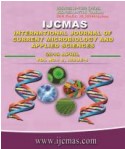


 National Academy of Agricultural Sciences (NAAS)
National Academy of Agricultural Sciences (NAAS)

|
PRINT ISSN : 2319-7692
Online ISSN : 2319-7706 Issues : 12 per year Publisher : Excellent Publishers Email : editorijcmas@gmail.com / submit@ijcmas.com Editor-in-chief: Dr.M.Prakash Index Copernicus ICV 2018: 95.39 NAAS RATING 2020: 5.38 |
A weed is essentially any plant which grows where it is not required. A weed can be thought of as any plant growing in the wrong place at the wrong time and doing more harm than good. Weeds are the most severe and widespread biological constraint to crop production, and cause invisible damage till the crop is harvested. The composition and competition by weeds are dynamic and dependent on soil, climate, cropping and management factors. Weeds decrease the value of land, particularly perennial weeds, which tend to accumulate on long fallows; increase cost of cleaning. Significant portion of farmer’s time is wasted for weeding of crops. Weeding is the removal of unwanted plants in the field crops. Mechanical weed control is very effective as it helps to reduce drudgery involved in manual weeding, it kills the weeds and also keeps the soil surface loose ensuring soil aeration and water intake capacity. Weeding is an important but equally labour intensive agricultural unit operation. There is an increasing interest in the use of mechanical intra-row weeders because of concern over environmental degradation and a growing demand for organically produced food. Today the agricultural sector requires non-chemical weed control that ensures food safety. Consumers demand high quality food products and pay special attention to food safety. A portable knapsack power weeder was developed with width of cut was 25 cm and tested in maize crop with number of blades per flange (2, 4 and 6). Operational speed, actual field capacity, field efficiency, weeding efficiency, plant damage, actual working depth of cut, fuel consumption, performance index of (2,4,6 blades per flange) was 0.42, 0.38 and 0.36 m/s, 0.028, 0.025 and 0.023 ha/h, 74.6, 66.6 and 61.3 per cent, 84.7, 87.9 and 89.3 per cent, 4.28, 3.43 and 2.40 per cent, 3.36, 3.83 and 4.33 cm,0.61, 0.67, and 0.70 l/h, 136, 127 and 120.
 |
 |
 |
 |
 |